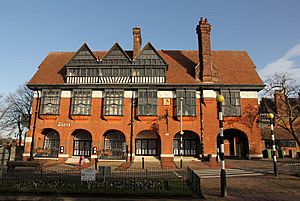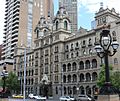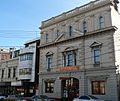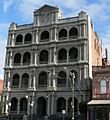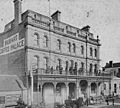Coffee palace facts for kids
A coffee palace was a large and fancy hotel, but with a special rule: it didn't serve any alcohol! Most of these grand buildings were built in Australia in the late 1800s. They were a popular alternative to regular pubs and hotels.

A Look Back in Time
In the 17th and 18th centuries, "coffee houses" were popular in the United Kingdom. They were like taverns but sold coffee instead of alcohol.
Why No Alcohol? The Temperance Movement
In the early 1800s, a movement called the temperance movement started in the United States and then spread to the United Kingdom. People in this movement believed that drinking too much alcohol was bad for people's health and society. They encouraged everyone to drink less or even stop drinking completely.
To help people avoid alcohol, the movement started building or converting places where people could meet, have fun, eat, and even stay overnight without any alcohol. The very first "temperance hotel" opened in 1833 in Preston, UK. These places were meant to be a friendly alternative to the local pub. They were called by different names like "temperance hotel," "coffee tavern," or "coffee rooms." By the 1870s, some of these hotels became very large and fancy, and a few were even called "coffee palaces."
Coffee Palaces Arrive in Australia
The temperance movement also became popular in Australia soon after it started in the UK. People in Australia wanted to create places that were "as attractive as possible" for everyone, especially working people. These places would offer fun and learning, just like a big hotel, but only serve coffee and other non-alcoholic drinks.
Unlike in the UK, many Australian coffee palaces were built as businesses, hoping to make a profit. The first "coffee house" companies started in Melbourne, Sydney, and Adelaide. The very first coffee palace, the Collingwood Coffee Palace, opened in Fitzroy, Melbourne, in 1879. Soon after, the very grand Melbourne Coffee Palace opened in the city in 1881.
This was a time of big economic growth in Australia, especially in Melbourne, which was experiencing a "land boom." Land prices were going up, and many large, fancy buildings were being constructed. Coffee palaces were often built in a grand style, with lots of decorations, like the Renaissance Revival style.
A politician named James Munro was a big supporter of the temperance movement in Victoria. In 1886, his company bought a famous hotel, the Grand, and turned it into a temperance hotel called the Grand Coffee Palace. It's said he even burned the alcohol license!
The Federal Coffee Palace, built in Melbourne in 1888, was the largest hotel in Australia at the time. The Grand Coffee Palace (the one James Munro bought) was the second largest in Melbourne.
The End of an Era
The coffee palace boom lasted for about ten years. It ended with a big banking crisis and a tough economic depression in 1893. Many coffee palaces struggled because people stopped visiting them, or they were built for customers who never arrived.
Some coffee palaces changed into guest houses or private hotels. Others decided to get alcohol licenses and stopped being called "coffee palaces." In the early 1900s, the name "coffee palace" was sometimes used for smaller hotels or guest houses, especially in holiday towns, to show they didn't serve alcohol. However, these smaller places didn't have the same grand style as the original coffee palaces.
Many of the large, old coffee palaces were eventually torn down between the 1950s and 1970s. This was because they were expensive to maintain and often became cheap boarding houses. However, a few important ones still exist today. The most famous survivor is the Hotel Windsor in Melbourne. It was originally the Grand Coffee Palace, but it got its alcohol license back in 1897 and changed its name in 1920. It's now one of Australia's most important grand hotels from the 1800s.
Famous Coffee Palaces
Many coffee palaces were built across Australia and even in the UK. Here are some notable examples:
Victoria
Melbourne
- Collingwood Coffee Palace, Fitzroy (1879): One of the first, later became part of a department store.
- Victoria Coffee Palace, Collins Street (1880): Part of it still exists as the Victoria Hotel.
- Melbourne Coffee Palace, Bourke Street (1881): A very grand early example, torn down around 1970.
- St Kilda Coffee Palace, St Kilda (1883): Still standing and now a hotel.
- Grand Coffee Palace, Spring Street (1884): This became the famous Hotel Windsor.
- Mentone Coffee Palace, Mentone (1887): Now part of Kilbreda College.
- Federal Coffee Palace, Melbourne (1888): The largest, demolished in 1972.
- McCaughans Coffee Palace, Spencer Street (1891): Now the Great Southern Hotel.
Ballarat
- Reid's Coffee Palace (1886): Now Reid's Guest House.
Bendigo
- Sandhurst Coffee Palace (demolished)
Bellarine Peninsula
- Barwon Heads Coffee Palace (1889): Destroyed by fire in 1928.
- Ocean Grove Coffee Palace (1888): Demolished in the late 1960s.
Other Victorian Towns
- Federal Coffee Palace, Yarram (1901).
- Mildura Coffee Palace, Mildura (1891): Became the Grand Hotel with an alcohol license in 1919.
- Ozone Coffee Palace, Warrnambool (1889): Destroyed by fire in 1929.
Tasmania
- Imperial (Hobart) Coffee Palace, Hobart, Tasmania: Built in sections from the 1880s.
- Tasmanian Coffee Palace, Hobart: Now home to the Mercury Print Museum.
- Federal (Sutton's) Coffee Palace, Launceston, Tasmania: Demolished in 1976.
South Australia
- Grand Coffee Palace, Hindley Street, Adelaide (1891): Now the Plaza Hotel.
- Grant's Coffee Palace, Hindley Street, Adelaide (1908): Later West's Coffee Palace.
- Port Pioneer Coffee Palace, Port Adelaide (1879).
- Kieselbach Coffee Palace, Mt. Gambier (1884): Later the Palace Hotel.
New South Wales
Sydney
- Johnsons Temperance Coffee Palace, York Street, Sydney (1879).
- Sydney Coffee Palace Hotel, George Street, Sydney, New South Wales (1880): Part of it still remains.
- Grand Central Coffee Palace, Clarence Street, Sydney (1889): Later became a licensed hotel and was demolished.
Country NSW
- Metropolitan Coffee Palace, Goulburn (1893).
- Dorrigo Coffee Palace, Dorrigo: Burned down twice.
Queensland
- People's Palace, Brisbane (1910–11): Still operating as a backpackers' hotel in 2015.
- Canberra Hotel, Brisbane (1929): Demolished later.
Western Australia
- Burnett's Coffee Palace and Temperance Hotel, Perth: Perth's first "Coffee Palace."
- Ellis's Grand Central Coffee Palace, Wellington St, Perth: Still standing as the Grand Central Hotel.
- Rechabite Coffee Palace, Wellington St, Perth.
United Kingdom
- Douglas Coffee Palace, Douglas, Isle of Man (c1870): Demolished in 1930.
- Ossington Coffee Tavern, Newark on Trent (1882).
- Cobden Coffee House, Corporation Street, Birmingham (1883): Demolished.
Images for kids




